thread造句
大学英语六级真题词汇分频速记手册(频率41-45次)【圣才出品】

频率41-45次suffer[ ]v. 受苦,受难;遭受,经历;忍受【例句】①The new plant can’t suffer the cold weather. 这种新植物不耐寒冷气候。
②She was suffering from a headache. 她正饱受头痛之苦。
【串记】sufferingspread[ ]v. 伸展,展开;传播,散布,蔓延【例句】①The vista spread seemingly to infinity. 景色似乎延绵不绝。
②The tornado spread destruction. 暴风造成的破坏蔓延开来。
③The word spread fast. 消息散布得很快。
【搭配】spread to传到,波及,蔓延到spread out张开,伸开,铺开;扩大[张],展开,伸长【串记】threadseek [ ] v. 寻找,探索;试图,企图【例句】①She sought out and acquired all his early paintings. 她找到并获得了他早期画的所有画儿。
②You must seek permission from the manager. 你必须获得经理的批准。
【搭配】seek after/for寻求,探索;追求;寻找seek out找出,搜出;挑出seek through找遍reserve[ ]n. 储备(物),储藏量;缄默;谨慎v.保留,储备;预订【例句】①I have reserved a room for you at the hotel. 我已在旅馆为你预订了一个房间。
②He has retreated to his former reserve. 他已经恢复了他从前保守的态度。
【搭配】in reserve留待以后用reserve price(尤指拍卖时)底价be reserved to留作…只用【串记】conserve, observe, deserve; reservationpromote[ ]v. 促进,增进;提升,提拔;宣传,推销【例句】①Our teacher has been promoted to headmaster. 我们的老师已被提升为校长了。
thread在java中的用法
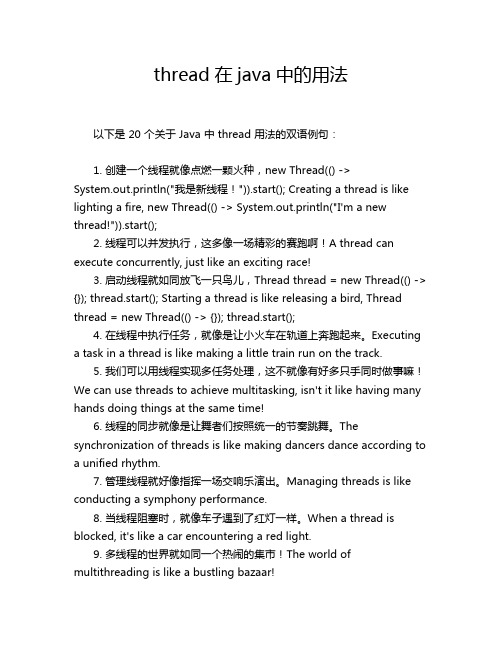
thread在java中的用法以下是 20 个关于 Java 中 thread 用法的双语例句:1. 创建一个线程就像点燃一颗火种,new Thread(() ->System.out.println("我是新线程!")).start(); Creating a thread is like lighting a fire, new Thread(() -> System.out.println("I'm a new thread!")).start();2. 线程可以并发执行,这多像一场精彩的赛跑啊!A thread can execute concurrently, just like an exciting race!3. 启动线程就如同放飞一只鸟儿,Thread thread = new Thread(() -> {}); thread.start(); Starting a thread is like releasing a bird, Thread thread = new Thread(() -> {}); thread.start();4. 在线程中执行任务,就像是让小火车在轨道上奔跑起来。
Executinga task in a thread is like making a little train run on the track.5. 我们可以用线程实现多任务处理,这不就像有好多只手同时做事嘛!We can use threads to achieve multitasking, isn't it like having many hands doing things at the same time!6. 线程的同步就像是让舞者们按照统一的节奏跳舞。
The synchronization of threads is like making dancers dance according toa unified rhythm.7. 管理线程就好像指挥一场交响乐演出。
英语
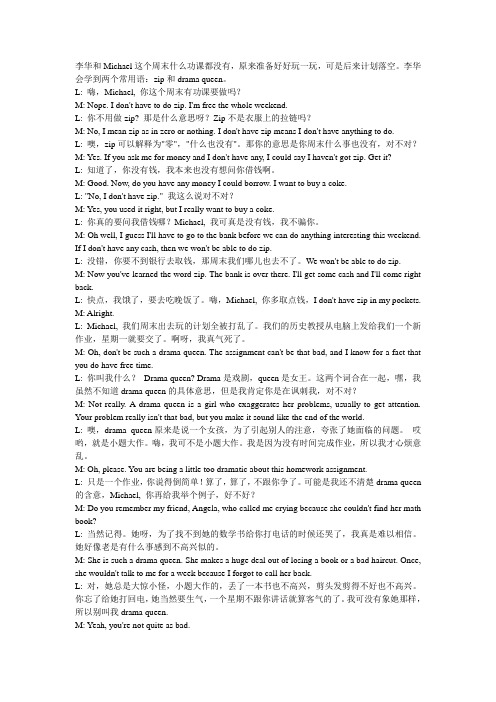
李华和Michael这个周末什么功课都没有,原来准备好好玩一玩,可是后来计划落空。
李华会学到两个常用语:zip和drama queen。
L: 嗨,Michael, 你这个周末有功课要做吗?M: Nope. I don't have to do zip. I'm free the whole weekend.L: 你不用做zip? 那是什么意思呀?Zip不是衣服上的拉链吗?M: No, I mean zip as in zero or nothing. I don't have zip means I don't have anything to do.L: 噢,zip可以解释为"零","什么也没有"。
那你的意思是你周末什么事也没有,对不对?M: Yes. If you ask me for money and I don't have any, I could say I haven't got zip. Get it?L: 知道了,你没有钱,我本来也没有想问你借钱啊。
M: Good. Now, do you have any money I could borrow. I want to buy a coke.L: "No, I don't have zip." 我这么说对不对?M: Yes, you used it right, but I really want to buy a coke.L: 你真的要问我借钱哪?Michael, 我可真是没有钱,我不骗你。
M: Oh well, I guess I'll have to go to the bank before we can do anything interesting this weekend. If I don't have any cash, then we won't be able to do zip.L: 没错,你要不到银行去取钱,那周末我们哪儿也去不了。
100个实用英语小词自由表达你思想
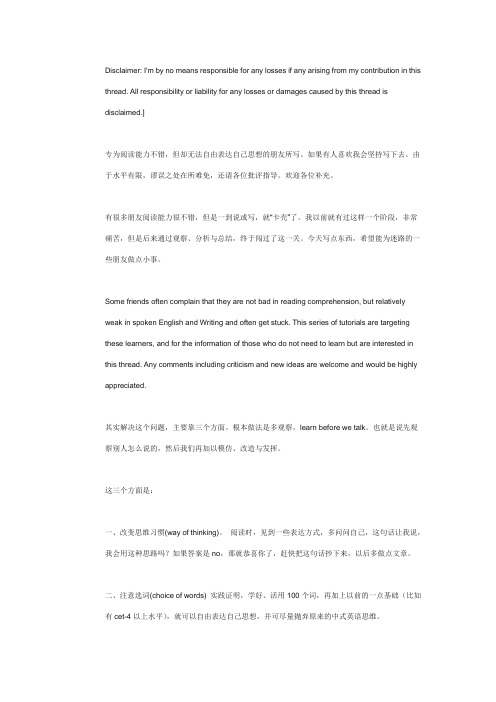
Disclaimer: I'm by no means responsible for any losses if any arising from my contribution in this thread. All responsibility or liability for any losses or damages caused by this thread is disclaimed.]专为阅读能力不错,但却无法自由表达自己思想的朋友所写。
如果有人喜欢我会坚持写下去。
由于水平有限,谬误之处在所难免,还请各位批评指导。
欢迎各位补充。
有很多朋友阅读能力很不错,但是一到说或写,就“卡壳”了。
我以前就有过这样一个阶段,非常痛苦,但是后来通过观察、分析与总结,终于闯过了这一关。
今天写点东西,希望能为迷路的一些朋友做点小事。
Some friends often complain that they are not bad in reading comprehension, but relatively weak in spoken English and Writing and often get stuck. This series of tutorials are targeting these learners, and for the information of those who do not need to learn but are interested in this thread. Any comments including criticism and new ideas are welcome and would be highly appreciated.其实解决这个问题,主要靠三个方面。
根本做法是多观察,learn before we talk。
也就是说先观察别人怎么说的,然后我们再加以模仿、改造与发挥。
Thread
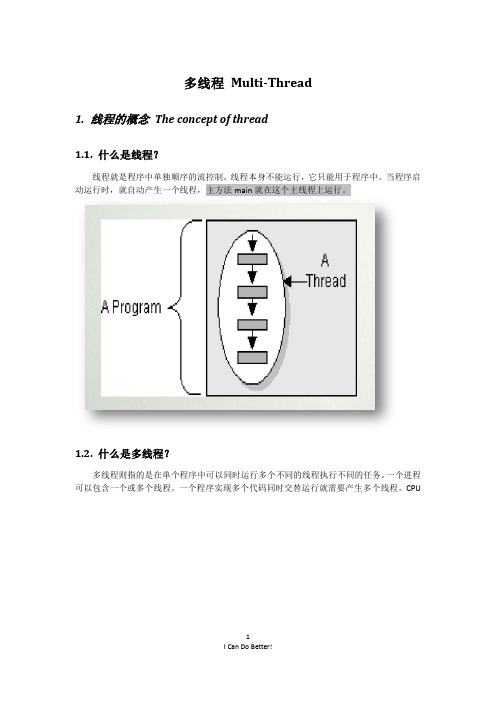
多线程Multi-Thread1. 线程的概念The concept of thread1.1. 什么是线程?线程就是程序中单独顺序的流控制。
线程本身不能运行,它只能用于程序中。
当程序启动运行时,就自动产生一个线程,主方法main就在这个主线程上运行。
1.2. 什么是多线程?多线程则指的是在单个程序中可以同时运行多个不同的线程执行不同的任务。
一个进程可以包含一个或多个线程。
一个程序实现多个代码同时交替运行就需要产生多个线程。
CPU随机的抽出时间,让我们的程序一会做这件事情,一会做另外一件事情。
同其他大多数编程语言不同,Java内置支持多线程编程(multithreaded programming)。
多线程程序包含两条或两条以上并发运行的部分,把程序中每个这样的部分都叫作一个线程(thread)。
每个线程都有独立的执行路径,因此多线程是多任务处理的一种特殊形式。
多任务处理被所有的现代操作系统所支持。
然而,多任务处理有两种截然不同的类型:基于进程的和基于线程的。
基于进程的多任务处理是更熟悉的形式。
进程(process)本质上是一个执行的程序。
因此基于进程的多任务处理的特点是允许你的计算机同时运行两个或更多的程序。
举例来说,基于进程的多任务处理使你在运用文本编辑器的时候可以同时运行Java编译器。
在基于进程的多任务处理中,程序是调度程序所分派的最小代码单位。
而在基于线程(thread-based)的多任务处理环境中,线程是最小的执行单位。
这意味着一个程序可以同时执行两个或者多个任务的功能。
例如,一个文本编辑器可以在打印的同时格式化文本。
说明:线程是程序内的顺序控制流,只能使用分配给程序的资源和环境。
1.3. 多线程编程的目的多线程编程的目的,就是"最大限度地利用CPU资源",当某一线程的处理不需要占用CPU而只和I/O等资源打交道时,让需要占用CPU资源的其它线程有机会获得CPU资源。
M9U3重点词汇(原创)
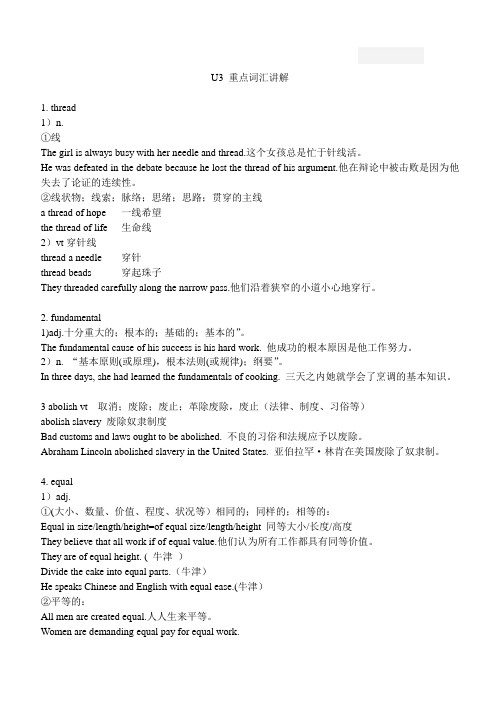
U3 重点词汇讲解1. thread1)n.①线The girl is always busy with her needle and thread.这个女孩总是忙于针线活。
He was defeated in the debate because he lost the thread of his argument.他在辩论中被击败是因为他失去了论证的连续性。
②线状物;线索;脉络;思绪;思路;贯穿的主线a thread of hope 一线希望the thread of life 生命线2)vt穿针线thread a needle 穿针thread beads 穿起珠子They threaded carefully along the narrow pass.他们沿着狭窄的小道小心地穿行。
2. fundamental1)adj.十分重大的;根本的;基础的;基本的”。
The fundamental cause of his success is his hard work. 他成功的根本原因是他工作努力。
2)n. “基本原则(或原理),根本法则(或规律);纲要”。
In three days, she had learned the fundamentals of cooking. 三天之内她就学会了烹调的基本知识。
3 abolish vt 取消;废除;废止;革除废除,废止(法律、制度、习俗等)abolish slavery 废除奴隶制度Bad customs and laws ought to be abolished. 不良的习俗和法规应予以废除。
Abraham Lincoln abolished slavery in the United States. 亚伯拉罕·林肯在美国废除了奴隶制。
4. equal1)adj.①(大小、数量、价值、程度、状况等)相同的;同样的;相等的:Equal in size/length/height=of equal size/length/height 同等大小/长度/高度They believe that all work if of equal value.他们认为所有工作都具有同等价值。
线程

{
SynchronizationThreadsExample STE = new SynchronizationThreadsExample();
STE.ThreadFunction( );
}
public void ThreadFunction ( )
[编辑本段]什么是多线程?
在计算机编程中,一个基本的概念就是同时对多个任务加以控制。许多程序设计问题都要求程序能够停下手
头的工作,改为处理其他一些问题,再返回主进程。可以通过多种途径达到这个目的。最开始的时候,那些
拥有机器低级知识的程序员编写一些“中断服务例程”,主进程的暂停是通过硬件级的中断实现的。尽管这
·多线程块模型(自由线程块模型)
多线程块模型(MTA)在每个进程里只有一个块而不是多个块。这单个块控制着多个线程而不是单个线程。这里不需要消息队列,因为所有的线程都是相同的块的一个部分,并且可以共享。这样的程序比单线程模型和STA的执行速度都要块,因为降低了系统的负载,因而可以优化来减少系统idle的时间。这些应用程序一般比较复杂,因为程序员必须提供线程同步以保证线程不会并发的请求相同的资源,因而导致竞争情况的发生。这里有必要提供一个锁机制。但是这样也许会导致系统死锁的发生。
[编辑本段]多线程在.NET里如何工作?
在本质上和结构来说,.NET是一个多线程的环境。有两种主要的多线程方法是.NET所提倡的:使用ThreadStart来开始你自己的进程,直接的(使用ThreadPool.QueueUserWorkItem)或者间接的(比如Stream.BeginRead,或者调用BeginInvoke)使用ThreadPool类。一般来说,你可以"手动"为长时间运行的任务创建一个新的线程,另外对于短时间运行的任务尤其是经常需要开始的那些,进程池是一个非常好的选择。进程池可以同时运行多个任务,还可以使用框架类。对于资源紧缺需要进行同步的情况来说,它可以限制某一时刻只允许一个线程访问资源。这种情况可以视为给线程实现了锁机制。线程的基类是System.Threading。所有线程通过CLI来进行管理。
Threads
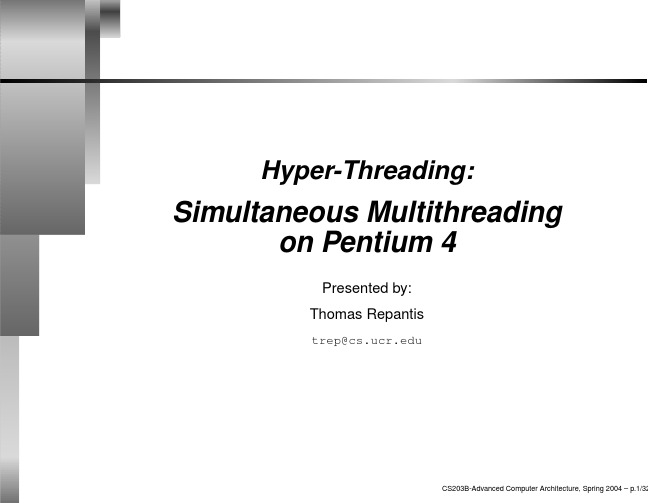
Specific positions are assigned to each processor.
CS203B-Advanced Computer Architecture, Spring 2004 – p.12/32
Dynamically Partitioned Queue
A limit is imposed to the positions each processor can use, but no specific positions are assigned.
• •
CS203B-Advanced Computer Architecture, Spring 2004 – p.15/32
Front-End Pipeline
(a) Trace Cache Hit
(b) Trace Cache Miss
CS203B-Advanced Computer Architecture, Spring 2004 – p.16/32
Sharing: + Enables efficient use of resources, but... - Allows a thread to monopolize a resource (e.g. cache thrashing).
CS203B-Advanced Computer Architecture, Spring 2004 – p.14/32
•
CS203B-Advanced Computer Architecture, Spring 2004 – p.20/32
OS Optimizations
The Linux kernel (2.6 series) distinguishes between logical and physical processors:
Java中Thread和Runnable的区别
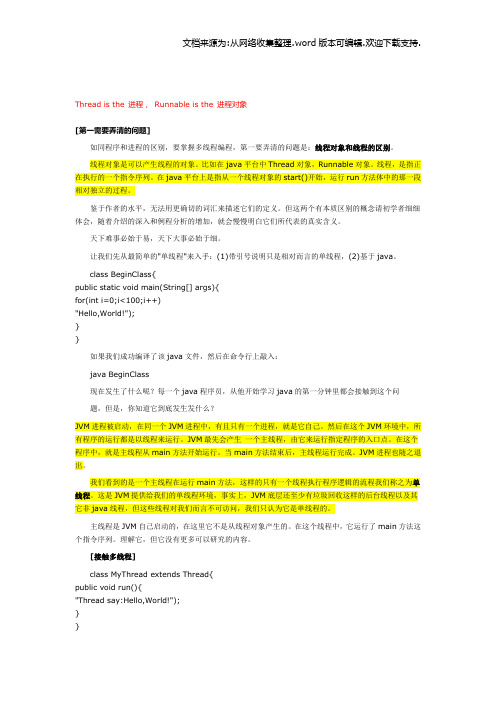
Thread is the 进程,Runnable is the 进程对象[第一需要弄清的问题]如同程序和进程的区别,要掌握多线程编程,第一要弄清的问题是:线程对象和线程的区别。
线程对象是可以产生线程的对象。
比如在java平台中Thread对象,Runnable对象。
线程,是指正在执行的一个指令序列。
在java平台上是指从一个线程对象的start()开始,运行run方法体中的那一段相对独立的过程。
鉴于作者的水平,无法用更确切的词汇来描述它们的定义。
但这两个有本质区别的概念请初学者细细体会,随着介绍的深入和例程分析的增加,就会慢慢明白它们所代表的真实含义。
天下难事必始于易,天下大事必始于细。
让我们先从最简单的"单线程"来入手:(1)带引号说明只是相对而言的单线程,(2)基于java。
class BeginClass{public static void main(String[] args){for(int i=0;i<100;i++)"Hello,World!");}}如果我们成功编译了该java文件,然后在命令行上敲入:java BeginClass现在发生了什么呢?每一个java程序员,从他开始学习java的第一分钟里都会接触到这个问题,但是,你知道它到底发生发什么?JVM进程被启动,在同一个JVM进程中,有且只有一个进程,就是它自己。
然后在这个JVM环境中,所有程序的运行都是以线程来运行。
JVM最先会产生一个主线程,由它来运行指定程序的入口点。
在这个程序中,就是主线程从main方法开始运行。
当main方法结束后,主线程运行完成。
JVM进程也随之退出。
我们看到的是一个主线程在运行main方法,这样的只有一个线程执行程序逻辑的流程我们称之为单线程。
这是JVM提供给我们的单线程环境,事实上,JVM底层还至少有垃圾回收这样的后台线程以及其它非java线程,但这些线程对我们而言不可访问,我们只认为它是单线程的。
2008高考词汇的另类记忆
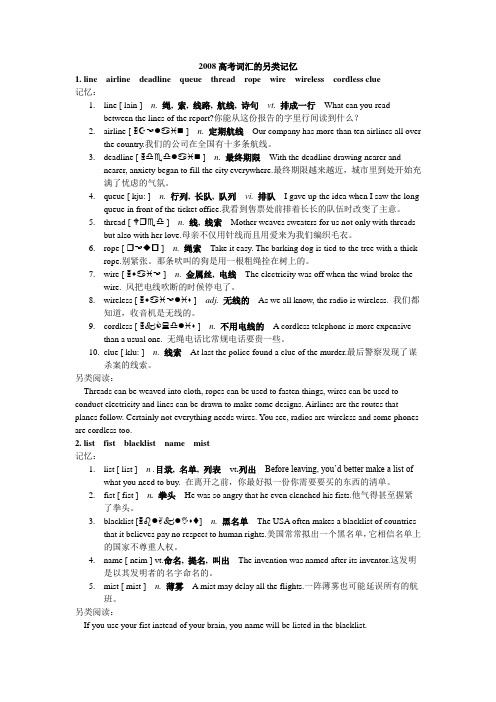
2008高考词汇的另类记忆1. line airline deadline queue thread rope wire wireless cordless clue记忆:1.line [ lain ] n. 绳, 索, 线路, 航线, 诗句vt. 排成一行What can you readbetween the lines of the report?你能从这份报告的字里行间读到什么?2.airline [ ☪☜●♋♓⏹ ] n. 定期航线Our company has more than ten airlines all overthe country.我们的公司在全国有十多条航线。
3.deadline [ ♎♏♎●♋♓⏹ ]n.最终期限With the deadline drawing nearer andnearer, anxiety began to fill the city everywhere.最终期限越来越近,城市里到处开始充满了忧虑的气氛。
4.queue [ kju: ] n.行列, 长队, 队列vi. 排队I gave up the idea when I saw the longqueue in front of the ticket office.我看到售票处前排着长长的队伍时改变了主意。
5.thread [ ❒♏♎ ] n.线, 线索Mother weaves sweaters for us not only with threadsbut also with her love.母亲不仅用针线而且用爱来为我们编织毛衣。
6.rope [ ❒☜◆☐ ] n.绳索Take it easy. The barking dog is tied to the tree with a thickrope.别紧张。
那条吠叫的狗是用一根粗绳拴在树上的。
7.wire [ ♦♋♓☜ ] n. 金属丝, 电线The electricity was off when the wind broke thewire. 风把电线吹断的时候停电了。
2词汇
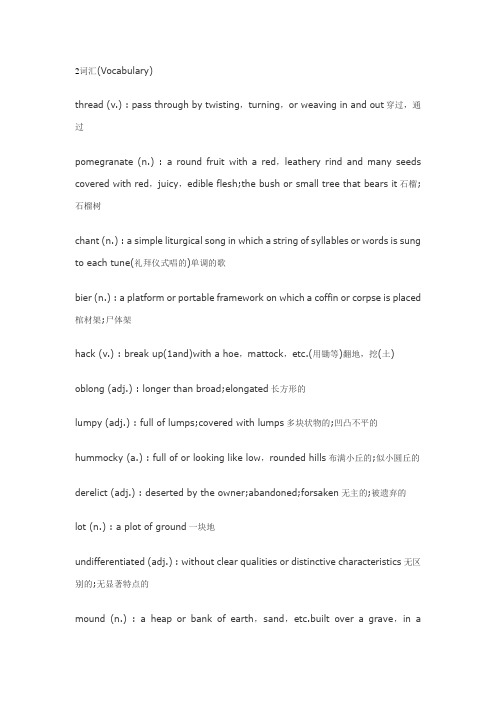
2词汇(Vocabulary)thread (v.) : pass through by twisting,turning,or weaving in and out穿过,通过pomegranate (n.) : a round fruit with a red,leathery rind and many seeds covered with red,juicy,edible flesh;the bush or small tree that bears it石榴;石榴树chant (n.) : a simple liturgical song in which a string of syllables or words is sung to each tune(礼拜仪式唱的)单调的歌bier (n.) : a platform or portable framework on which a coffin or corpse is placed 棺材架;尸体架hack (v.) : break up(1and)with a hoe,mattock,etc.(用锄等)翻地,挖(土)oblong (adj.) : longer than broad;elongated长方形的lumpy (adj.) : full of lumps;covered with lumps多块状物的;凹凸不平的hummocky (a.) : full of or looking like low,rounded hills布满小丘的;似小圆丘的derelict (adj.) : deserted by the owner;abandoned;forsaken无主的;被遗弃的lot (n.) : a plot of ground一块地undifferentiated (adj.) : without clear qualities or distinctive characteristics无区别的;无显著特点的mound (n.) : a heap or bank of earth,sand,etc.built over a grave,in afortification,etc.土堆;堤;坟堆prickly (adj.) : full of prickles多刺的prickly pear : any of a genus of cactus plants having cylindrical or large,flat,oval stem joints and edible fruits仙人掌(属)bumpy (adj.) : full of bumps;rough;jolting崎岖不平的;颠簸的;震摇的gazelle (n.) : any of various small,swift,graceful antelopes瞪羚hindquarter (n.) : either of the two hind legs and the adjoining loin of a carcass of veal,beef,lamb,etc.;[p1.]the hind part of a four-legged animal(牛、羊、猪等的)后腿肉;[复](四肢动物的)后躯nibble (v.) : take small,cautious,or gentle bites小口地咬;谨慎地咬(啃)butt (v.) : strike or push with the head or horns:ram with the head(用头或角)撞击;顶撞mid-air (n.) : any point in space,not in contact with the ground or other surface 空中;上空navvy (n.) : n unskilled laborer,as on canals,roads,etc.劳工;无特殊技术的工人sidle (v.) : move sideways,esp.in a shy or stealthy manner(羞怯或偷偷地)侧身行走stow (v.) : pack or store away;fill by packing in an orderly way装载;装进;收藏municipality n.a city,town. etc.having its own incorporated government for local affairs自治市(或镇)ghetto (n.) : (in certain European cities)a section to which Jews were formerly restricted(某些欧洲城市中从前的)犹太人居住区sore (adj.) : giving or feeling physical pain;painful疼痛的;感到疼痛的skull-cap (n.) : a light,closefitting,brimless cap,usually worn indoors(室内戴的)无沿便帽infest (v.) : overrun or inhabit in large numbers,usually so as to be harmful or bothersome;swarm in or over(虫害等)侵扰;骚扰;蔓延booth (n.) : a stall for the sale of goods,as at markets or fairs(市场或集市上的)货摊;摊店,摊棚prehistoric (adj.) : pertaining to ancient times,very old-fashioned老式的;古旧的warp (v.) : become bent or twisted out of shape变弯曲;变歪frenzied (adj.) : full of uncontrolled excitement疯狂的,狂乱的clamour (v.) : make a loud confused noise or shout;cry out喧嚷,喧嚣,吵闹grope (v.) : feel or search about blindly,hesitantly,or uncertainly摸索;探索self-contained (adj.) : having within oneself or itself all that is necessary;self-sufficient,as a community自给自足的witchcraft (n.) : the power or practices of witches: black magic;sorcery巫术;魔法square (adj.[colloq.]) : satisfying;solid;substantial[口]令人满意的;充实的conspicuous (adj.) : attracting attention by being unexpected,unusual,outstanding惹人注目的,显眼的grove (n.) : orchard果园legionnaire (n.) : a member of a legion军团的成员back-breaking (adj.) : requiring great physical exertion;very tiring费劲的;辛苦的,累人的desolate (adj.) : uninhabited;deserted荒无人烟的,荒凉的lucerne (n.) : a type of plant whose leaves grow in groups of three and which is used for feeding farm animals紫花苜蓿fodder (n.) : gorse food for cattle,horses,sheep,etc. as cornstalks,hay and straw(牛、马、羊的)粗饲料;饲草yoke (v.) : put a yoke on;join together;link用轭连起;连合;连结harrow (n.) : a heavy frame with spikes or sharp-edged disks,drawn by a horse 0r tractor and used for breaking up and leveling plowed ground,covering seeds,rooting up weeds,etc.耙furrow (n.) : a narrow groove made in the ground by a plow沟,畦;犁沟trickle (n.) : the act of trickling;a slow,small flow滴,淌;细流;subsoil (n.) : the layer of soil beneath the surface soil底土,下层土,mummify (v.) : shrivel or dry up干瘪;枯干;成木乃伊状hobble (v.) : go unsteadily,haltingly,etc.蹒跚leathery (adj.) : 1ike leather in appearance or texture. tough and flexible(外观或质地)似皮革的;坚韧的,粗硬的infuriate (v.) : cause to become very angry;enrage(使)发怒,激怒-damnably (adv.) : execrably该诅咒地;极坏地packsaddle (n.) : a saddle with fastenings to secure and balance the load carried by a pack animal驮鞍bridle (n.) : a head harness for guiding a horse马勒halter (n.) : a rope,cord,strap,etc.,usually with a headstall,for tying or leading an animal;a bitless headstall,with or without a lead rope缰绳;(马)笼头gut (n.[usu.in p1.]) : the bowels;entrails[常用复]内脏plight (n.) : condition or state of affairs;esp,now, an awkward.sad,or dangerous situation情况;状态;(现尤指)苦境;困境或险境gall (v.) : injure or make sore by rubbing;chafe擦伤,擦痛;磨stork (n.) : any of a family of large,long-legged,mostly old-world wading birds.having a long neck and bill,and related to the herons鹳reach-me-down (adj.[colloq.]) : second-hand or ready-made(衣服)用旧的;别人用过的;现成的khaki (adj.) : made of khaki(cloth)卡其(布)制的squash (v.) : force one's way;squeeze挤进,挤入slump (v.) : have a drooping posture or gait低头弯腰(而行);消沉inquisitive (adj.) : inclined to ask many questions or seek information;eager to learn好询问的;好奇的syphilis (n.) : an infectious venereal disease,caused by a spirochete and usually transmitted by sexual intercourse or acquired congenitally梅毒garrison (n.) : troops stationed in a fort or fortified place驻军;卫戍部队charger (n.) : a horse ridden in battle or on parade战马, 军马短语(Expressions)square meal: a complete and satisfying meal美餐丰盛的、令人满足in a cloud: a large number of small things moving through the air as amass一团例:a cloud of locusts一群蝗虫get at: to approach or reach到达,得到例:You have to use a little ladder to get at the jars on the top shelves.你得使用一把小梯才可以拿到架子上面的坛子。
python中thread的用法
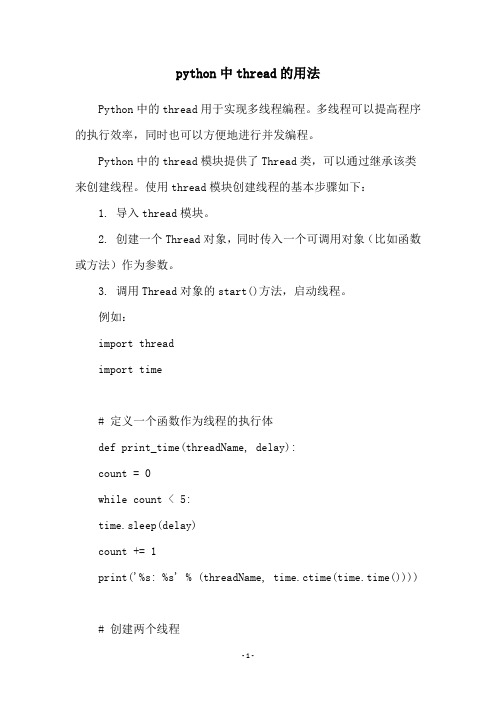
python中thread的用法Python中的thread用于实现多线程编程。
多线程可以提高程序的执行效率,同时也可以方便地进行并发编程。
Python中的thread模块提供了Thread类,可以通过继承该类来创建线程。
使用thread模块创建线程的基本步骤如下:1. 导入thread模块。
2. 创建一个Thread对象,同时传入一个可调用对象(比如函数或方法)作为参数。
3. 调用Thread对象的start()方法,启动线程。
例如:import threadimport time# 定义一个函数作为线程的执行体def print_time(threadName, delay):count = 0while count < 5:time.sleep(delay)count += 1print('%s: %s' % (threadName, time.ctime(time.time()))) # 创建两个线程try:thread.start_new_thread(print_time, ('Thread-1', 2,)) thread.start_new_thread(print_time, ('Thread-2', 4,)) except:print('Error: unable to start thread')# 等待所有线程执行完毕while 1:pass上述代码中,我们定义了一个print_time()函数作为线程的执行体,该函数会打印出当前时间并等待一段时间。
然后我们通过thread.start_new_thread()函数创建了两个线程,并启动它们。
最后我们使用一个无限循环等待所有线程执行完毕。
除了使用thread模块创建线程之外,Python中还可以使用threading模块来实现多线程编程。
threading模块提供了更高级别的线程操作接口,使用起来更加方便。
英语造句 with ,和in

英语造句 with ,和inTitle: The Dance of Life: Harmony and Diversity.Life is a tapestry woven with threads of diverse colors, textures, and origins. Just as a skilled artisan carefully selects and arranges each thread to create a masterpiece,so does life present us with a canvas where we must findour own harmony and beauty. This harmony does not come easily, nor is it found in isolation. It is forged through interactions, experiences, and the continuous dance of give and take with the world.In the realm of education, for instance, the dance oflife becomes particularly evident. Schools are not just places of learning; they are microcosms of society,reflecting the rich tapestry of human diversity. Children from different cultures, backgrounds, and abilities come together to learn, grow, and sometimes clash. It is inthese clashes that the true test of harmony lies.Consider a classroom where children from various parts of the world gather. Some are fluent in English, while others struggle with the language barrier. Some are comfortable with the culture and norms of the school, while others feel like outsiders. It is in this diverse setting that the dance of life begins.The teacher, a skilled facilitator, guides the children through this dance. She encourages them to collaborate, to share their stories and perspectives. She creates opportunities for them to learn from each other, to understand that each child has something unique to contribute. Slowly, the children begin to appreciate the beauty of diversity.As they learn together, they also learn to accept and embrace their differences. They realize that each culture, each language, and each ability brings a unique richness to the classroom. They learn to appreciate the value of "with" the collaboration, the shared understanding, and the mutual growth that comes from working together.Outside the classroom, the dance of life continues. In the workplace, communities, and families, we encounter diverse individuals with different perspectives and experiences. It is through these interactions that we learn to navigate the complexities of human relationships. We learn to respect, to understand, and to embrace the differences that make us stronger as a society.However, the dance of life is not always smooth. Conflicts arise, misunderstandings persist, and differences can sometimes seem insurmountable. It is in these moments that the importance of "in" becomes apparent. It is the space within us where we can reflect, understand, and grow. It is the space where we can connect with our own values, beliefs, and aspirations.By retreating into this inner space, we can gainclarity and perspective. We can reevaluate our ownpositions and understandings. We can find the courage to embrace our differences and the wisdom to appreciate the beauty of diversity.In conclusion, the dance of life is a continuous harmonious movement between "with" and "in". It is the dance of collaboration and understanding, of growth and transformation. It is the dance that weaves the tapestry of human life, making each thread, each color, and each moment unique and valuable. As we continue to dance, we create a world that is more inclusive, understanding, and harmonious a world where the beauty of diversity is fully realized and celebrated.。
线程的单词
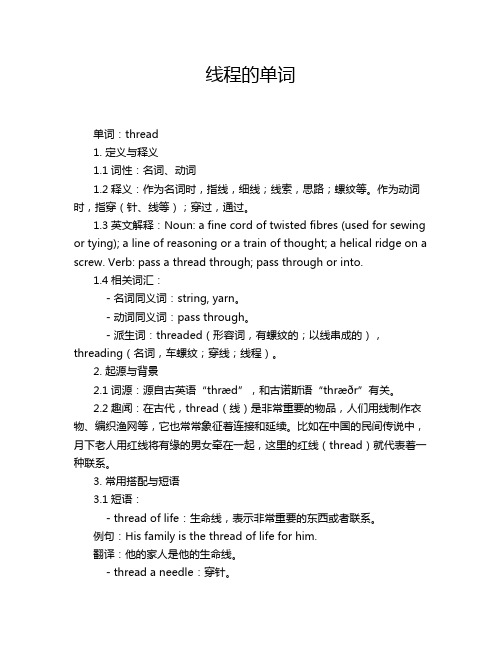
线程的单词单词:thread1. 定义与释义1.1词性:名词、动词1.2释义:作为名词时,指线,细线;线索,思路;螺纹等。
作为动词时,指穿(针、线等);穿过,通过。
1.3英文解释:Noun: a fine cord of twisted fibres (used for sewing or tying); a line of reasoning or a train of thought; a helical ridge on a screw. Verb: pass a thread through; pass through or into.1.4相关词汇:- 名词同义词:string, yarn。
- 动词同义词:pass through。
- 派生词:threaded(形容词,有螺纹的;以线串成的),threading(名词,车螺纹;穿线;线程)。
2. 起源与背景2.1词源:源自古英语“thræd”,和古诺斯语“thræðr”有关。
2.2趣闻:在古代,thread(线)是非常重要的物品,人们用线制作衣物、编织渔网等,它也常常象征着连接和延续。
比如在中国的民间传说中,月下老人用红线将有缘的男女牵在一起,这里的红线(thread)就代表着一种联系。
3. 常用搭配与短语3.1短语:- thread of life:生命线,表示非常重要的东西或者联系。
例句:His family is the thread of life for him.翻译:他的家人是他的生命线。
- thread a needle:穿针。
例句:It takes her a long time to thread a needle because of her poor eyesight.翻译:由于视力不好,她穿针要花很长时间。
- pick up the thread:继续(中断的话头)。
例句:After the break, he picked up the thread of his story.翻译:休息之后,他继续讲他的故事。
Python-Thread(通俗易懂)

Python-Thread(通俗易懂) 此类表⽰在单独的控制线程中运⾏的活动,有两种⽅法可以指定该活动,⼀是将可调⽤对象传递给构造函数,⼆是通过覆盖⼦类中的run()⽅法。
如果你对线程不太理解,我们可以打个⽐⽅,把线程数看作车辆数,我们来完成⼀个简单的客运运输⼯作(以下为了⽅便理解,也加⼊相应注释)。
更多threading模块函数和对象说明,可参考:⼀、⽆线程:⽰例:import timestart = time.time()people = 500 # 假设有500个⼈def action(num):global peoplewhile people>0:people -= 50 # 每次运输50⼈print("车辆编号:%d, 当前车站⼈数:%d" %(num, people))time.sleep(1)num = 1 # 车辆编号action(num)end = time.time()print("Duration time: %0.3f" %(end-start))运⾏结果:C:\Python37\python.exe Y:/Project-python/threading/test.py车辆编号:1, 当前车站⼈数:450车辆编号:1, 当前车站⼈数:400车辆编号:1, 当前车站⼈数:350车辆编号:1, 当前车站⼈数:300车辆编号:1, 当前车站⼈数:250车辆编号:1, 当前车站⼈数:200车辆编号:1, 当前车站⼈数:150车辆编号:1, 当前车站⼈数:100车辆编号:1, 当前车站⼈数:50车辆编号:1, 当前车站⼈数:0Duration time: 10.001Process finished with exit code 0⼆、单线程:编码⽰例:import threadingimport timestart = time.time()people = 500 # 假设有500个⼈def action(num):global peoplewhile people>0:people -= 50 # 每次运输50⼈print("车辆编号:%d, 当前车站⼈数:%d" %(num, people))time.sleep(1)num = 1 # 车辆编号vehicle = threading.Thread(target=action, args=(num,)) # 新建车辆vehicle.start() # 启动车辆vehicle.join() # 检查到站车辆end = time.time()print("Duration time: %0.3f" %(end-start))运⾏结果:C:\Python37\python.exe Y:/Project-python/threading/test.py车辆编号:1, 当前车站⼈数:450车辆编号:1, 当前车站⼈数:400车辆编号:1, 当前车站⼈数:350车辆编号:1, 当前车站⼈数:300车辆编号:1, 当前车站⼈数:250车辆编号:1, 当前车站⼈数:200车辆编号:1, 当前车站⼈数:150车辆编号:1, 当前车站⼈数:100车辆编号:1, 当前车站⼈数:50车辆编号:1, 当前车站⼈数:0Duration time: 10.001Process finished with exit code 0三、多线程(传递对象⽅式):编码⽰例:# -*- coding: utf-8 -*import threadingimport timepeople = 500 # 假设有500个⼈def action(num):global peoplewhile people>0:people -= 50 # 每次运输50⼈print("车辆编号:%d, 当前车站⼈数:%d" %(num, people))time.sleep(1)start = time.time()vehicles = [] # 新建车辆组for num in range(5):vehicle = threading.Thread(target=action, args=(num,)) # 新建车辆vehicles.append(vehicle) # 添加车辆到车辆组中for vehicle in vehicles:vehicle.start() # 分别启动车辆for vehicle in vehicles:vehicle.join() # 分别检查到站车辆end = time.time()print("Duration time: %0.3f" % (end-start))运⾏结果:C:\Python37\python.exe Y:/Project-python/threading/test.py车辆编号:0, 当前车站⼈数:450车辆编号:1, 当前车站⼈数:400车辆编号:2, 当前车站⼈数:350车辆编号:3, 当前车站⼈数:300车辆编号:4, 当前车站⼈数:250车辆编号:2, 当前车站⼈数:200车辆编号:1, 当前车站⼈数:150车辆编号:0, 当前车站⼈数:100车辆编号:3, 当前车站⼈数:50车辆编号:4, 当前车站⼈数:0Duration time: 2.001Process finished with exit code 0四、多线程(覆盖⼦类⽅式)编码⽰例:# -*- coding: utf-8 -*import threadingimport timepeople = 500class MyThread(threading.Thread):def__init__(self, num):super(MyThread, self).__init__()self.num = numdef run(self):global peoplewhile people > 0:people -= 50print("车辆编号:%d, 当前车站⼈数:%d " % (self.num, people)) time.sleep(1)start = time.time()vehicles = [] # 新建车辆组for num in range(5): # 设置车辆数vehicle = MyThread(num) # 新建车辆vehicles.append(vehicle) # 添加车辆到车辆组中vehicle.start() #启动车辆for vehicle in vehicles:vehicle.join() # 分别检查到站车辆end = time.time()print("Duration time: %0.3f" % (end-start))运⾏结果:C:\Python37\python.exe Y:/Project-python/threading/test.py车辆编号:0, 当前车站⼈数:450车辆编号:1, 当前车站⼈数:400车辆编号:2, 当前车站⼈数:350车辆编号:3, 当前车站⼈数:300车辆编号:4, 当前车站⼈数:250车辆编号:0, 当前车站⼈数:200车辆编号:2, 当前车站⼈数:150车辆编号:3, 当前车站⼈数:100车辆编号:1, 当前车站⼈数:50车辆编号:4, 当前车站⼈数:0Duration time: 2.003Process finished with exit code 0五、结果分析 1. 通过结果不难发现,不使⽤线程类和使⽤单线程运⾏时间是⼀样的,因为我们正常执⾏⼀个脚本,本质上就是单线程。
Thread的wait、sleep、join、yied理解
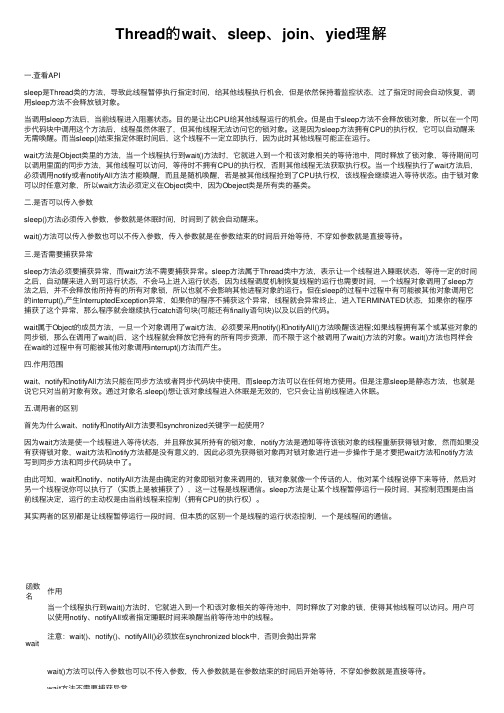
Thread的wait、sleep、join、yied理解⼀.查看APIsleep是Thread类的⽅法,导致此线程暂停执⾏指定时间,给其他线程执⾏机会,但是依然保持着监控状态,过了指定时间会⾃动恢复,调⽤sleep⽅法不会释放锁对象。
当调⽤sleep⽅法后,当前线程进⼊阻塞状态。
⽬的是让出CPU给其他线程运⾏的机会。
但是由于sleep⽅法不会释放锁对象,所以在⼀个同步代码块中调⽤这个⽅法后,线程虽然休眠了,但其他线程⽆法访问它的锁对象。
这是因为sleep⽅法拥有CPU的执⾏权,它可以⾃动醒来⽆需唤醒。
⽽当sleep()结束指定休眠时间后,这个线程不⼀定⽴即执⾏,因为此时其他线程可能正在运⾏。
wait⽅法是Object类⾥的⽅法,当⼀个线程执⾏到wait()⽅法时,它就进⼊到⼀个和该对象相关的等待池中,同时释放了锁对象,等待期间可以调⽤⾥⾯的同步⽅法,其他线程可以访问,等待时不拥有CPU的执⾏权,否则其他线程⽆法获取执⾏权。
当⼀个线程执⾏了wait⽅法后,必须调⽤notify或者notifyAll⽅法才能唤醒,⽽且是随机唤醒,若是被其他线程抢到了CPU执⾏权,该线程会继续进⼊等待状态。
由于锁对象可以时任意对象,所以wait⽅法必须定义在Object类中,因为Obeject类是所有类的基类。
⼆.是否可以传⼊参数sleep()⽅法必须传⼊参数,参数就是休眠时间,时间到了就会⾃动醒来。
wait()⽅法可以传⼊参数也可以不传⼊参数,传⼊参数就是在参数结束的时间后开始等待,不穿如参数就是直接等待。
三.是否需要捕获异常sleep⽅法必须要捕获异常,⽽wait⽅法不需要捕获异常。
sleep⽅法属于Thread类中⽅法,表⽰让⼀个线程进⼊睡眠状态,等待⼀定的时间之后,⾃动醒来进⼊到可运⾏状态,不会马上进⼊运⾏状态,因为线程调度机制恢复线程的运⾏也需要时间,⼀个线程对象调⽤了sleep⽅法之后,并不会释放他所持有的所有对象锁,所以也就不会影响其他进程对象的运⾏。
thread的用法总结大全
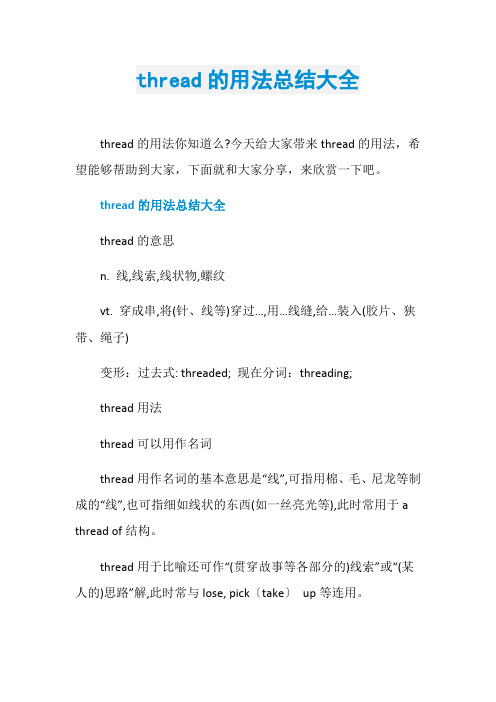
thread的用法总结大全thread的用法你知道么?今天给大家带来thread的用法,希望能够帮助到大家,下面就和大家分享,来欣赏一下吧。
thread的用法总结大全thread的意思n. 线,线索,线状物,螺纹vt. 穿成串,将(针、线等)穿过…,用…线缝,给…装入(胶片、狭带、绳子)变形:过去式: threaded; 现在分词:threading;thread用法thread可以用作名词thread用作名词的基本意思是“线”,可指用棉、毛、尼龙等制成的“线”,也可指细如线状的东西(如一丝亮光等),此时常用于a thread of结构。
thread用于比喻还可作“(贯穿故事等各部分的)线索”或“(某人的)思路”解,此时常与lose, pick〔take〕up等连用。
thread还可作“螺纹”“衣物,衣服”解,作“衣物,衣服”解时多见于美国俚语中,且常用于复数形式。
thread可以用作动词thread的基本意思是将一根线穿进针眼中,指在比较狭窄或拥挤的地方穿梭(如在人群中挤过去),即“穿线,穿过”,常与介词into, on, through等连用。
thread一般用作及物动词,接名词或代词作宾语,偶尔也可接双宾语,其间接宾语可以转化为介词for的宾语。
thread泛指统指为“线”,而thread指“一根线”,复数形式threads指“多根线”。
thread用法例句1、A thin, glistening thread of moisture ran along the rough concrete sill.在粗糙不平的水泥窗台上有一条细细的发光水印。
2、She idly pulled at a loose thread on her skirt.她无聊地扯着裙子上一根松掉的线头。
3、A ratchet mechanism transfers the thread from spool to bobbin.一种棘齿装置把线从线轴转到梭心上。
一道面试题:说说进程和线程的区别
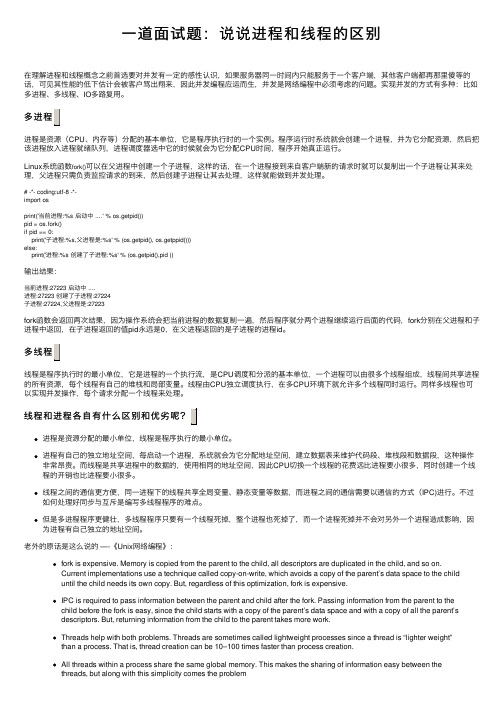
⼀道⾯试题:说说进程和线程的区别在理解进程和线程概念之前⾸选要对并发有⼀定的感性认识,如果服务器同⼀时间内只能服务于⼀个客户端,其他客户端都再那⾥傻等的话,可见其性能的低下估计会被客户骂出翔来,因此并发编程应运⽽⽣,并发是⽹络编程中必须考虑的问题。
实现并发的⽅式有多种:⽐如多进程、多线程、IO多路复⽤。
多进程进程是资源(CPU、内存等)分配的基本单位,它是程序执⾏时的⼀个实例。
程序运⾏时系统就会创建⼀个进程,并为它分配资源,然后把该进程放⼊进程就绪队列,进程调度器选中它的时候就会为它分配CPU时间,程序开始真正运⾏。
Linux系统函数fork()可以在⽗进程中创建⼀个⼦进程,这样的话,在⼀个进程接到来⾃客户端新的请求时就可以复制出⼀个⼦进程让其来处理,⽗进程只需负责监控请求的到来,然后创建⼦进程让其去处理,这样就能做到并发处理。
# -*- coding:utf-8 -*-import osprint('当前进程:%s 启动中 ....' % os.getpid())pid = os.fork()if pid == 0:print('⼦进程:%s,⽗进程是:%s' % (os.getpid(), os.getppid()))else:print('进程:%s 创建了⼦进程:%s' % (os.getpid(),pid ))输出结果:当前进程:27223 启动中 ....进程:27223 创建了⼦进程:27224⼦进程:27224,⽗进程是:27223fork函数会返回两次结果,因为操作系统会把当前进程的数据复制⼀遍,然后程序就分两个进程继续运⾏后⾯的代码,fork分别在⽗进程和⼦进程中返回,在⼦进程返回的值pid永远是0,在⽗进程返回的是⼦进程的进程id。
多线程线程是程序执⾏时的最⼩单位,它是进程的⼀个执⾏流,是CPU调度和分派的基本单位,⼀个进程可以由很多个线程组成,线程间共享进程的所有资源,每个线程有⾃⼰的堆栈和局部变量。
